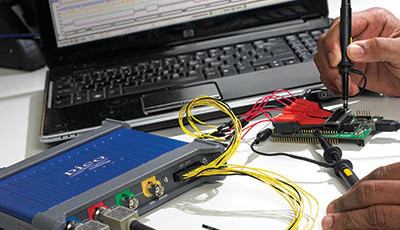PicoScopes with Deeper Memory
on

Pico Technology has announced that its 3000D Series oscilloscopes launched in October last year now offer deeper memory. This comes on the back of last November’s release of beta drivers for Mac OS X and Linux operating systems for their range of oscilloscopes and data loggers adding to the existing Windows driver. This makes them suitable for use with the BeagleBone Black and Raspberry Pi development boards.
All scopes in this range feature deep memory, allowing high sampling rates to be maintained even at slower sweep speeds for capturing long waveforms in fine detail. Sampling at 1 Gsample/s it can capture a 500 msec waveform (half a billion samples) while hardware acceleration takes care of smooth display updating. Here's a summary of the specifications of the new PicoScope 3000D Series:
- 2 or 4 analog channels
- Up to 200 MHz bandwidth
- Up to 512 MS buffer size
- Built-in arbitrary waveform generator (AWG)
- USB 3.0 interface
- Powered by USB (separate adapter option included)
- Optional 16-channel logic input for mixed-signal oscilloscope (MSO) operation
- Advanced PicoScope software with digital triggering, serial decoding, mask limit testing, math channels and many other features, all included as standard.
The 3000D Series with 16 digital inputs allows you to view digital and analog signals simultaneously.
The digital inputs can be displayed individually or in named groups with binary, decimal or hexadecimal values shown in a bus-style display. A separate logic threshold from –5 V to +5 V can be defined for each 8-bit input port. The digital trigger can be activated by any bit pattern combined with an optional transition on any input. Advanced logic triggers can be set on either the analog or digital input channels, or both to enable complex mixed-signal triggering.
The digital inputs allow decoding of serial data on all analog and digital channels simultaneously, giving up to 20 channels of data. This allows you to decode multiple SPI, I²C, CAN bus, LIN bus and FlexRay signals at the same time. For more information contact Pico Technology.



Discussion (0 comments)